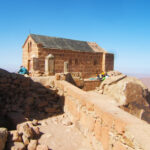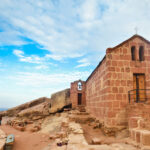ǦABAL MŪSĀ (HAGION OROS)
| Hebrew | הר סיני |
| Greek | Ἅγιον ὄρος | Τουρσινα | Σιναί |
| Latin | Syna |
| Arabic | جبل موسى |
| English | Mount Sinai | Gebel Musa |
| French | Mont Sinaï | Gebel Moussa | Gebel Musa | Jabal Musa |
| DEChriM ID | 53 |
| Trismegistos GeoID | 8835 |
| Pleiades ID | 746815 | PAThs ID | - |
| Ancient name | Hagion Oros |
| Modern name | Ǧabal Mūsā |
| Latitude | 28.538745 |
| Longitude | 33.975472 |
| Date from | 362 |
| Date to | 560 |
| Typology | Church |
| Dating criteria | - |
| Description | The site of Ǧabal Mūsā, also known as Hagion Oros, hagia Koryphe, the Holy Summit, or Mountain of the Law, is situated in southern Sinai, in the immediate proximity of St. Catherine’s Monastery. Considered the location where Moses received the Ten Commandments (an association first attested to in the fourth or fifth century), it has understandably for many centuries been a key pilgrimage destination for Jews, Christians and Muslims alike (Panayotidi and Kapoissi-Verti 2009: 187; Kapoissi-Verti and Panayotidi 2010: 73, 75). A three-aisled timber roofed basilica was constructed on the summit in the second half of the sixth century, during the reign of Justinian, dated based on the fact that textual references made to the structure only occur after 560 CE, coupled with the architectural similarities shared by it and the Justinianic katholikon of St. Catherine’s Monastery (Panayotidi and Kapoissi-Verti 2009: 187). The chapel was destroyed at some point, likely by an earthquake, and a mosque was erected atop it in the 11th/12th century, incorporating architectural elements of the destroyed basilica (Panayotidi and Kapoissi-Verti 2009: 187-188). Throughout the years, numerous smaller chapels have been built, with the final phase having been the construction of the single-aisle chapel of the Holy Trinity, erected in the early 20th century and still standing today. Like the preceding constructions, this chapel also incorporated architectural elements of the Justinianic church including the three-sided apse (Panayotidi and Kapoissi-Verti 2009: 188; Kapoissi-Verti and Panayotidi 2010: 84). The feature of interest for the project lies in a pre-Justinianic structure identified during excavations “carefully enclosed in the north aisle when the small basilica was built” (Panayotidi and Kapoissi-Verti 2009: 189, fig. 4). This structure is considered by the excavators to be the small oratory built in 362-363 by St. Julianos, as recorded by Theodoret of Cyrrhys in his philotheos historia (c. first half of the fifth century), and perhaps also referenced by the pilgrim Egeria who visited c. 383CE (Panayotidi and Kapoissi-Verti 2009: 189; Kapoissi-Verti and Panayotidi 2010: 76, 87- 88, fig. 26). Though there is indeed an amount of material datable to the fourth century, namely glass shards, which attest to presence at that time, the dating of this earlier structure to the fourth century is far from certain (Kapoissi-Verti and Panayotidi 2010: 93). |
| Archaeological research | The first ground plan of the structure was made by P. Grossmann in the late 1980s (Grossmann 1989), but the only archaeological work to have occurred here was that of the Hellenic Archaeological Mission to South Sinai, who conducted four seasons in 1998-1999, and another three seasons in 2008. Initially directed by M. Panayotidi and S. Kalopissi-Verti, the later missions were directed by N. Fyssas (Kalopissi-Verti and Panayotidi. 2015: 2; Kapoissi-Verti and Panayotidi 2010: 80). Work was financed by the Greek Ministry of Culture, with technical assistance provided by the University of Athens. |
• Dahari, U. 2000. Monastic Settlements in South Sinai in the Byzantine Period: The Archaeological Remains, 28-37. Jerusalem: Israel Antiquities Authority.
• Grossmann, P. 1989. “Neue frühchristliche Funde aus Ägypten.” In Actes du XIe Congrès International d’archéologie chrétienne, Lyon, Vienne, Grenoble, Genève et Aoste, 21-28 Septembre 1986, edited by N. Duval, F. Baritel and P. Pergola, 1843-1908. Rome: École française de Rome; Città del Vaticano: Pontificio Istituto di archaeologia cristiana.
• Grossmann, P. 1999-2000. “Wadi Fayran/Sinai: Report on the Seasons in March and April 1985 and 1986 with an Appendix on the Church at Mount Moses.” Annales du service des antiquités de l’Égypte 75: 157-171.
• Kapoissi-Verti, S. and M. Panayotidi. 2010. “Excavations on the Holy Sumit (Jebel Mūsā) at Mount Sinai: Preliminary Remarks on the Justinianic Basilica.” In Approaching the Holy Mountain. Art and Liturgy at St. Catherine’s Monastery in Sinai, edited by S. E. J. Gerstel and R. S. Nelson, 73-106. Turnhout: Brepols.
• Kalopissi-Verti, S. and M. Panayotidi. 2015. “Excavations on the Holy Summit (Mount Moses) and at the Site East of St. Catherine’s Monastery in South Sinai.” In Proceedings of the Multidisciplinary Conference on the Sinai Desert, edited by E. De John, T. Van Gool, C. Moors and Z. El Houbba, 104-118. The Netherlands-Flemish Institute in Cairo.
• Koufopoulos, P. And M. Myriantheos-Koufopoulou. Forthcoming. Ἡ ἀρχιτεκτοωική τῆς βασιλικῆς τοῦ Ἰουστινιανοῦ και τῶν παρεκκλησίων τῆς Ἀγίας Κορυφῆς τοῦ Σινᾶ.” Σιναϊτικὰ Ἀναλεκτα 2.
• Manginis, G. 2010. “Hagia Koryphē (Jabal Mūsā) in Sinai, Egypt.” Unpublished PhD Dissertation, University of London, School of Oriental and African Studies.
• Panayotidi, M. and S. Kalopissi-Verti. 2009. “Excavation of the Justinianic Basilica on the Holy Summit (Jabal Mūsā) at Mount Sinai.” In Ideologia e cultura artistica tra Adriatico e Mediterraneao orientale (iv-x secolo). Il ruolo dell’autorità ecclesiastica alla luce di nuovi scavi e ricerche, edited by R. F. Campanati, C. Rizzardi, P. Porta, A. Augenti and I. B. Lippolis, 187-190. Bologna: Ante Quem.


 Json data
Json data





